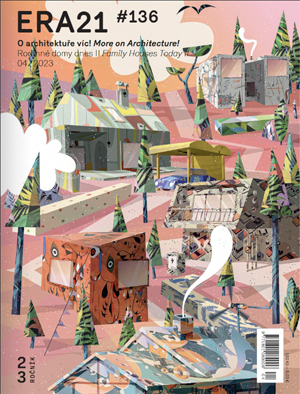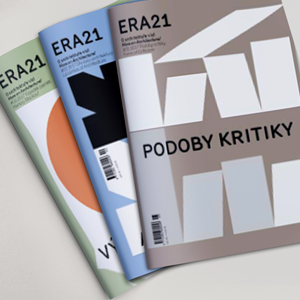| » entire article | ||
| news | ||
| completed project |
From Tractors to Philharmonics. Restoration of the National Pavilion Z at České Budějovice Exhibition Centre » A key element in the design of Libor Erban and Jan Benda’s 1970s exhibition pavilion was its massing, with three simple box volumes stacked on top of each other like an inverted pyramid. Over time, this principle became suppressed and unclear. Recovering, redefining and redeveloping it was the main goal of the restoration project. One part of the pavilion reveals its load-bearing structure. New program arrangement is expressed in the combination of solid and translucent forms, with the right-hand side enclosed and the left-hand side more open and airy. The restored pavilion uses new and sophisticated building operation systems, which are not concealed but installed in a new technology tower. |
|
| intro |
The Temple of the Sun » The Sun Under the Radotín Bridge art installation was created in June 2022 during a three-day art festival called the Summer Solstice, part of the Art for the City project supported by the Prague City Gallery. The reinforced concrete piers and arches of the bridge transformed themselves into a ceremonial space, with a monumental radiant wheel of straw hanging above, symbolising harvest, abundance and the revitalising power of the Sun. |
|
| starting points |
From Object to Processes. We Don’t Need a Builder, Let’s Look for a Shared Landscape Vision » Namely, landscape architecture connects—becomes a mediator—using a shared vision of humans coexisting with nature, a vision of landscape. The older definition, calling it an art of creating spaces for people with a combination of natural (water, ground, vegetation) and artificial elements, becomes outdated and inadequate. This approach isolated landscape architects from all other industries that formed landscapes. Though still an inextricable part of the work, mastering the craft of building outdoor spaces does not define the field of landscape architecture any more. |
|
| interview |
Landscape Architects Are Used to Taking Long-Term Approaches. Martin Arfalk Interviewed by Veronika Kučerová » New city districts, parks, and landscape studies grow under his hands. Martin Arfalk and his Mandaworks studio show the full scope of landscape architecture projects. In a conversation with Veronika Kučerová, he explains his take on the role of landscape architects, what they can and should influence, and how important thinking of the future really is. |
|
| practice |
Focused on Process. Emscher Landscape Park and Green Infrastructure Ruhr—Experiences with Long Term and Regional Urban Landscape Development and European Environmental Initiatives » The Emscher river valley’s unique revitalisation strategy is most often represented by the highly photogenic Duisburg-Nord landscape park. One of the ten best city parks in the world according to The Guardian, this post-industrial park is a flagship project and at the same time one of over a hundred initiation projects in the joint strategic vision called the Emscher Park. This is not a single landscape project that helped change a place with a compex history, but a long line of small steps and projects tied together by a common vision. |
|
| completed project |
Nature Park in a Housing Estate. Gellerup Estate Central Park Revitalisation in Aarhus » Almost a decade in the making, Gellerup estate central park revitalisation transformed this empty and un-programmed wilderness into a lush city park with new sport and leisure program areas. Gellerup housing estate was designed and erected in the 1960s in the modernist architectural style typical for the era. Gellerup is one of Denmark’s largest social housing estates with many social, cultural, and economic challenges. The central park’s complex revitalisation plays an important role in the effort to solve these problems. The project brings new and better social opportunities and activities to the area, restores and improves the paths network and public lighting, and removes old and overgrown green clutter to ensure a good overview of the park and increase overall security. |
|
| completed project |
Sponge City. Praterstern Vienna Public Space Revitalisation » The key principle of the revitalisation of public space around the Praterstern transport hub in Vienna, Austria, was the significant increase of green areas. The resulting improvements in rainwater retention and related cooling effect in the public spaces helped activate the square and make it accessible for different user groups. Other architectural elements also respond to various climate change challenges and help reduce the heat island effect. However, the biggest change of all is almost completely invisible, because it happened underground. A highly sophisticated drainage system combined with tree plantings in structural soil made Praterstern into a “spongia”—a water-absorbing sponge which is then capable of using all of the stored water without waste. |
|
| completed project |
Garden of the Future. Courtyard Revitalisation in Copenhagen » Combining modern climate change adaptation principles with residents' relaxation and gathering areas, this courtyard revitalisation is a rainwater management demonstration project, part of the Copenhagen Climate Adaptation Plan. Instead of going directly into the sewer, rainwater becomes the centerpiece of the design—it is collected, filtered and recirculated, until it finally reaches a small lake. The project was developed in a collaborative process with the residents and Copenhagen Municipality which fostered better local support and ownership. |
|
| interview |
Let’s Concern Ourselves with the Renaissance of River Landscapes. Klára Salzmann Interviewed by Alice Boušková » For centuries on end we laboured to dry out our landscapes. That was the way things were done, and anyway water was plentiful. But times change, and today we should try to restore water instead. We will not succeed without good spatial and landscape planning, without collaboration with building and landscape architects and urban designers, and without citizen participation. In this interview, Klára Salzmann, a landscape architect who makes river landscapes and water management her main professional focus, shared with us her rich experience in this matter. |
|
| practice |
A Tree Is Not Just for Decoration. Experience with Prague City Vegetation Maintenance » As we know, tree avenues play a key and irreplaceable role in the climate change adaptation of our cities. We also know that in a challenging city environment it’s not enough to simply plant a tree and trust it will manage on its own. We can only expect trees to prosper and fulfil the necessary functions like cooling streets, cleaning air, or preventing floods, when we provide them with adequate living conditions. |
|
| practice |
The National Museum Park in Collaboration with Whomever » You have to collaborate with others when working in the city centre, despite many still being opposed to the idea. Someone or something will make you. There’s no point resisting, though it does happen. There is a point in enquiring, analysing, listening, finding competent people and sustainable solutions. All that sounds quite sensible and simple. But the truth is very different. The revitalisation of Čelakovského sady in Prague was successful in that it changed many things, cleared new ways through the snow, and also followed some paths already made by others. |
|
| experiences |
Reform. On the State and Direction of the Landscape Architecture Profession » Urbanist and landscape architect Milota Sidorová introduces professionals working in the field of landscape architecture or at intersections with neighbouring fields. Among those invited for interviews were Karolína Koupalová, Helena Pánková, Jitka Trevisan, Kristýna Stará, Sandra Štasselová, Lenka Kudrnová, Michala Hrnčiarová, and Alice Boušková. |
|
| idea |
Asphalt Jungle » A small paved courtyard in a social housing project in Paris was turned into an experimental garden. The garden illustrates innovative climate change adaptation approaches—increasing stormwater infiltration capacity, reducing urban heat island effects, and creating no additional waste since all pavement and soil materials are reused in situ. The project was produced through FAIRE, a Paris City innovative urban projects accelerator. |
|
| trends |


ERA21 vydává ERA Média, s. r. o. |
|
|
Phone: +420 530 500 801 E-mail: redakce@era21.cz |
|
| WEBdesign Kangaroo group, a.s. |